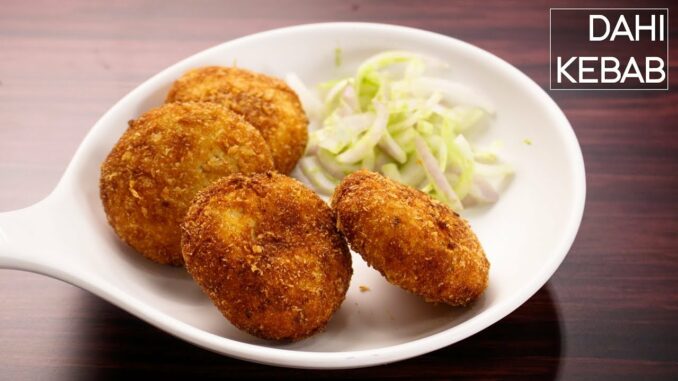
Introduction:
Dahi Kebab, a culinary gem deeply rooted in Indian cuisine, offers a tantalizing blend of creamy textures and aromatic spices. This delectable dish transforms yogurt, or dahi in Hindi, into a savory delight that transcends ordinary expectations. In this extensive guide, we embark on a culinary odyssey, unraveling the intricacies of crafting the perfect Dahi Kebab—a dish that epitomizes the rich heritage and diverse flavors of Indian cooking.
I. The Essence of Dahi Kebab:
Dahi Kebab, a vegetarian delight, celebrates the versatility of yogurt as a primary ingredient. The preparation involves blending yogurt with an array of spices, herbs, and other ingredients to create a flavorful mixture. This mixture is then shaped into kebabs and either deep-fried or baked to perfection, resulting in a crispy exterior and a melt-in-your-mouth interior.
II. Gathering the Ingredients:
To embark on the journey of crafting Dahi Kebab, gather the following ingredients:
- 2 cups thick yogurt (hung curd)
- 1 cup crumbled paneer (cottage cheese)
- 1/4 cup finely chopped onions
- 1/4 cup finely chopped bell peppers (red and green)
- 2 tablespoons gram flour (besan)
- 2 tablespoons finely chopped coriander leaves
- 1 tablespoon finely chopped mint leaves
- 1 tablespoon ginger-garlic paste
- 1 teaspoon roasted cumin powder
- 1 teaspoon garam masala
- 1 teaspoon red chili powder
- Salt to taste
- 1 cup bread crumbs (for coating)
- Oil for frying or baking
III. Preparing the Hung Curd:
- Straining the Yogurt:
- To achieve the desired thickness for Dahi Kebab, strain the yogurt using a muslin cloth or a fine sieve. Allow it to hang for a few hours or overnight, letting the excess whey drain out. This results in hung curd with a creamy consistency.
IV. Creating the Dahi Kebab Mixture:
- Mixing the Ingredients:
- In a large mixing bowl, combine the hung curd, crumbled paneer, finely chopped onions, bell peppers, gram flour, coriander leaves, mint leaves, ginger-garlic paste, roasted cumin powder, garam masala, red chili powder, and salt. Blend the ingredients thoroughly to form a cohesive mixture.
- Adjusting Consistency:
- If the mixture is too soft, add a little more gram flour or breadcrumbs to achieve the desired consistency. The mixture should be firm enough to shape into kebabs without losing its structure.
V. Shaping and Coating the Kebabs:
- Shaping the Kebabs:
- With the Dahi Kebab mixture ready, take small portions and shape them into flat, oval or cylindrical kebabs. Ensure they are compact and hold their shape well.
- Coating with Bread Crumbs:
- Roll each shaped kebab in breadcrumbs, coating them evenly. The breadcrumbs add a crispy texture to the exterior of the kebabs when they are fried or baked.
VI. Cooking the Dahi Kebabs:
- Frying Method:
- Heat oil in a pan for frying. Once the oil is hot, gently place the kebabs in the oil and fry until they turn golden brown on all sides. Use a slotted spoon to remove excess oil, and place the fried kebabs on absorbent paper.
- Baking Method:
- For a healthier alternative, preheat your oven to 375°F (190°C). Place the breadcrumb-coated kebabs on a greased baking sheet and bake for 20-25 minutes or until they achieve a golden-brown hue.
VII. Serving and Presentation:
- Garnishing the Kebabs:
- Before serving, garnish the Dahi Kebabs with a sprinkle of freshly chopped coriander leaves or mint leaves. This adds a burst of freshness and visual appeal to the dish.
- Accompaniments:
- Serve the Dahi Kebabs hot with mint chutney, tamarind sauce, or a yogurt-based dip. These accompaniments enhance the overall flavor profile and provide a delightful contrast.
- Pairing Suggestions:
- Dahi Kebabs make a wonderful appetizer or snack. Pair them with a side salad or serve them as part of a larger Indian feast alongside biryani, naan, or other traditional dishes.
VIII. Flavor Variations and Customizations:
While the basic Dahi Kebab recipe is a culinary masterpiece on its own, consider experimenting with flavor variations and customizations:
- Nutty Twist: Add finely chopped nuts such as cashews or almonds to the kebab mixture for added crunch and nutty flavor.
- Cheesy Delight: Incorporate grated cheese into the mixture to create a gooey and indulgent variation of Dahi Kebabs.
- Herb-Infused Kebabs: Experiment with herbs like dill, thyme, or basil to infuse a unique and aromatic twist to the kebab mixture.
IX. Storing and Reheating:
- Refrigeration: Store any leftover Dahi Kebabs in an airtight container in the refrigerator for up to 2-3 days.
- Reheating: To reheat, place the kebabs in a preheated oven at 350°F (175°C) for approximately 10 minutes or until they are warmed through. Alternatively, use a microwave for a quicker reheating option.
X. Conclusion:
The art of crafting the perfect Dahi Kebab lies in the meticulous balance of ingredients and the infusion of traditional Indian flavors. With this comprehensive guide, you now possess the knowledge and skills to embark on a culinary journey that celebrates the rich heritage of Indian cuisine. Whether served as an appetizer, a party snack, or a flavorful addition to a festive spread, Dahi Kebabs are sure to captivate the senses and become a cherished dish in your culinary repertoire. Embrace the tradition, savor the flavors, and delight in the creation of these creamy and spiced vegetarian kebabs that embody the essence of Indian gastronomy.